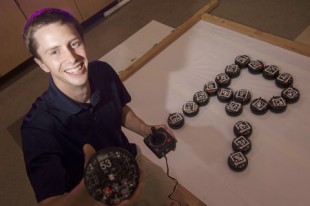Sep 10 2013
The next experiment from Rice University’s Multi-Robot Systems Laboratory (MRSL) could happen on your desktop. The lab’s researchers are refining their control algorithms for robotic swarms based upon data from five free online games that anyone can play.
 Postdoctoral researcher Aaron Becker designed a new control algorithm that allows swarms of r-one robots from Rice's Multi-Robot Systems Laboratory to complete complex tasks -- including spelling out Rice's trademark R.
Postdoctoral researcher Aaron Becker designed a new control algorithm that allows swarms of r-one robots from Rice's Multi-Robot Systems Laboratory to complete complex tasks -- including spelling out Rice's trademark R.
“What we learn from the game and our lab experiments applies directly to real-world challenges,” said Aaron Becker, a postdoctoral researcher at MRSL. “For example, if a doctor had a swarm of several thousand microscopic robots, each carrying a tiny payload of anti-cancer drugs, might it be possible to have them all converge on a tumor using magnetic signals from an MRI machine?”
In the games, players use simple commands to move groups of robots through mazes and around obstacles. Sometimes the goal is to push a larger object to a particular spot. Other times the goal is to move the collective to a target or to have it assume a specific shape. Each time a game is played, the website collects information about how the task was completed. Becker said the data will be used to develop new control algorithms for robot swarms.
“The data from these games will help us better understand how to use multi-robot systems with massive populations to perform coordinated, complex tasks,” said lab director James McLurkin, assistant professor of computer science at Rice.
To demonstrate the kind of complex behaviors that can be achieved with simple commands, Becker videotaped an experiment over the Labor Day weekend in which a swarm of a dozen randomly scattered r-one robots were directed to form a complex shape — a capital R. To direct the robots, Becker used a basic controller — a simple one-button, ’80s-era videogame joystick that was capable of giving only two commands: rotate and roll forward.
“The robots are all connected to the same joystick, so each robot received exactly the same commands,” Becker said.
The experiments were the latest to use the r-one, an inexpensive yet sophisticated multi-robot system that McLurkin began designing in 2009. Each bagel-sized r-one has a radio, a motor, two wheels, dozens of sensors and onboard electronics. R-ones are up to 10 times less expensive than previously available research-grade swarm robots.
In the Labor Day experiment, Becker’s control algorithm directed each r-one in the swarm to a unique, pre-programmed, end position. The algorithm did this by taking advantage of slight differences in each robot’s response to the two simple commands. In a computer simulation, Becker also showed how the same technique could be used to direct a 120-robot swarm to both spell out “Rice” and display the shape of the university’s owl mascot.
“The controller commands all the robots to rotate, and prior to giving the forward command, the controller measures the location and orientation of each member of the swarm with an overhead camera,” Becker said. “The algorithm collapses all of that information into a single number — a measurement of error — and tries to make this error as small as possible.
To reduce the error measure, the controller exploits “rotational noise.”
“Each time the joystick tells the robots to turn, every robot turns a slightly different amount due to random wheel slip,” Becker said. “The controller uses these differences to slowly drive the swarm to its goal. This is where the algorithmic results are critical. It might take thousands of individual commands to produce a complex shape, but the proof shows that the algorithm will always produce the desired goal positions.”
“It’s counterintuitive,” McLurkin said. “Common sense would seem to indicate that you’d need to issue individual commands to each robot to move the group into complex patterns, but that is not the case. The beauty of the algorithm is that each simple move brings the entire group closer to the goal.”
He said the demonstration is the first step toward a more ambitious goal.
“Aaron’s new work is aimed at using environmental obstacles to perform more complex tasks and to simultaneously control hundreds or thousands of robots,” McLurkin said. “That may sound like science fiction, but Rice chemist James Tour is developing massive populations of nanorobots right now, just two buildings over. His group can build many trillions of these in a single batch.”
Becker said the current algorithm is slow, and data from the online games will be used to design new control algorithms that are as much as 200 times faster.
Becker, who will wrap up a yearlong postdoctoral stint at MRSL later this month, will continue his research at his next postdoctoral assignment at Harvard University and Boston Children’s Hospital.
MRSL research is supported by the National Science Foundation.